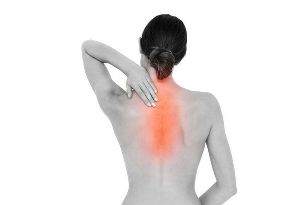
Bone tumors affecting the thoracic spine are often considered pathology of internal organs. It is manifested by heart attacks, shortness of breath, a feeling of lack of air upon inhalation, and panic attacks. Therefore, diagnosis of thoracic bone tumor is somewhat difficult. Once discovered, conservative treatment is carried out using medications, physical therapy, exercise therapy. And for serious damage to the disc and thoracic vertebrae, surgical intervention is required.
Brief description of the disease
Chest fibroids are a degenerative-dystrophic disease of the spine. In the early stages of development, the disc is slowly destroyed. They become thin, brittle and appear radial cracks on their surface. To stabilize the thoracic segment affected by bone resorption, the bone tissue of the vertebra develops with the formation of acute growth spikes - osteoclasts. This becomes the cause of limited vigorous mobility, squeezing blood vessels and spinal roots.
The degree of disease
The degree of bone necrosis is a set of symptoms characteristic of a given x-ray stage. The more deformed discs and vertebrae, the more pronounced clinical manifestations are. The severity of the pathology always determines the treatment strategies, it must be taken into account when choosing drugs and the method of using them.
I degree
X-ray images usually don't show any changes. But the disc has begun to deflate due to its inability to retain moisture, which is necessary for the repair of its tissues. Sometimes there is a slight discomfort in the back that quickly disappears after a short period of rest. Bone necrosis disease grade 1 is often discovered by accident during the diagnosis of other diseases.

degree II
The loops have become loose, ragged. One of the cracks in the surface of the disc increases, and the pulp enlarges there. On x-ray film, a decrease in the distance between adjacent vertebral bodies may be observed due to a decrease in the height of the disc. Due to constant compensating muscle tension, the motor capacity of the thoracic region is limited and moderate pain occurs.
degree III
The integrity of the annular fibrosus is violated, thus the pulp core is squeezed out of it. Cranial convex formations - the main cause of severe symptoms and severe complications of necrosis of the chest bone. The vertebral bodies are deformed, forming single vertebrae. Pain in the chest area becomes constant, the range of motion of the spine is significantly reduced.
IV degree
X-ray images clearly show the development of connective tissue, the formation of many osteoblasts. Adjacent vertebrae are blocked, immobile. Developmental lens syndrome, often myelopathy - compression of the spinal cord, dangerous because of its irreversible consequences. A person who has almost no self-service in everyday life, loses the ability to perform professional tasks.
Causes of necrosis of the thoracic spine
Thoracic fibroids in people over 40-45 years old develop due to the natural aging process of the body: slow down the recovery response, reduce collagen production, cause elasticity, durability of the ropeligaments. At a younger age, it occurs due to increased stress on the spine or by diseases already in the body:
- rheumatoid arthritis, systemic lupus erythematosus, scleroderma, ankylosing spondylitis;
- endocrine and metabolic diseases, for example, diabetes mellitus, gout, hypothyroidism, hyperthyroidism;
- birth defects and acquired, including scoliosis, scoliosis.
Previous spinal injury, sedentary lifestyle, lack of vitamins and trace elements in the body can cause premature disc destruction.
Typical signs and symptoms of disease

C thoracic fibroids develop gradually, not manifesting themselves at first. It is in this process that its dangers lie. A person has mild back pain and discomfort from mediocre muscle fatigue after a tiring day at work, housework or gardening and not seeking medical help. Therefore, usually patients are diagnosed with a 2-3 degree pathology, which is difficult for conservative treatment.
Right from the start
During the onset of illness, pathology may manifest as pain between the shoulder blades, which occurs when bending or rotating. Range of motion is reduced and there are specific signs of recurrence.
Chest pain
In bone necrosis, chest pain appears first. They are not clearly localized, they can be brought out to the hand, to the collarbone, to the ribs. Severe or moderate heart pain, like an angina, is not eliminated with nitroglycerin. Sometimes they are similar to the sensations occurring during exacerbation of cholecystitis, pancreatitis. But unlike damage to the pancreas or gallbladder, the pain is not accompanied by increased gas production, heartburn, and bloating.
Chest constriction
Pain between the shoulder blades is sometimes accompanied by a feeling of lack of air when inhaled. One is expected to panic, not understanding the reason for this state. Doctors recommend not to panic, but to sit down and measure your pulse. If the value obtained does not exceed 100 beats per minute, then the likelihood of a lung or heart interrupting is extremely low.
Other Symptoms
Gradually, symptoms of osteonecrosis are exacerbated by susceptibility disorder. There is a feeling of numbness, tingling, ants crawling. Sometimes, panic-like conditions occur. They are characterized by fear, increased heart rate, heavy sweating and cold sweats. If these symptoms are associated with chest pain, then nitroglycerin should be taken and called a doctor. A similar set of symptoms may indicate a heart attack.

The roots of the spine, located in the chest area, nourish the internal organs. When they are stimulated, the compression will disrupt the work of the digestive tract and liver. Intestinal motility is disturbed, epigastric pain, heartburn, and belching occur.
Signs in a subacute stage
After an exacerbation, a subacute phase of thoracic necrosis begins. Pain and shortness of breath continued, but they were much less severe. A person is no longer looking for a comfortable position of the body for a long time in which no pain is felt. The duration of the semi-acute period is up to two weeks. If all medical recommendations are followed, remission will occur, which is characterized by the absence of pronounced symptoms. Violation of the treatment regimen leads to a new exacerbation of bone necrosis disease.
Cancel
During remission, mild discomfort may occur with changing weather or hypothermia. Acute pain appears only with bone necrosis of 2-4 degrees severe due to excessive rotation or tilt of the body. Exacerbation of a chronic pathology, stress, increased physical activity, prolonged in one location of the body can cause a relapse of another disease.
Principles of diagnosis
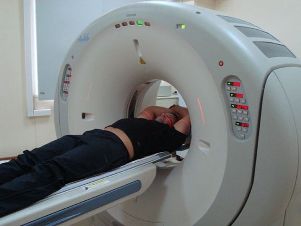
The neurologist makes the primary diagnosis based on the patient's complaints, the medical history data. On an external examination, he discovered spots in the chest area, which had pain in the pressure. Conduct functional tests that allow you to assess the safety of the reflex, to identify sensitive disorders. Among the instrumental methods, radiography is the most informative. But for a detailed study of the spinal segment, CT, MRI can be performed. To rule out diseases of the cardiovascular system, the patient is assigned an electrocardiogram.
First aid
Pain during recurrence of thoracic necrosis is acute, penetrating, so patients need to be first aid promptly. It should be soothed, laid on a hard surface, covered with a warm blanket. If the recurrence is accompanied by increased heart rate, shortness of breath, and increased anxiety, you should call your doctor. Any nonsteroidal anti-inflammatory drug can be used to relieve the pain between the shoulder blades.
How to treat breast bone tumors
There is only one comprehensive treatment that eliminates all symptoms of osteonecrosis, slows or completely stops its spread to healthy disc and vertebrae. With a pathology of 1-2 severity, conservative treatments are used. For grade 3-4 bone necrosis, the formation of large herniated masses is characteristic. Surgical treatment may be required to relieve pressure on blood vessels and spinal roots.
Preparations

In treatment, thoracic destruction drugs of many different pharmacological and clinical groups are used. In the early stages, parenteral drugs are often used to quickly bring about a therapeutic effect. A few days later, the injection solution is replaced with safer pills, ointments and ointments.
Nonsteroidal anti-inflammatory drugs (NSAIDs)
NSAIDs have a pronounced analgesic, anti-inflammatory, and anti-edema effect. Intramuscular injection of the solution allows to stop acute pain. To eliminate a slight discomfort between the shoulder blades, topical agents are used. And with moderate pain, NSAIDs for oral administration work well.
Muscle relaxants
A muscle relaxant is used to reduce muscle spasm during severe pain. Usually, treatment of bone necrosis in the chest begins with intramuscular injection of drugs, in addition to the muscle relaxant tolperisone, including an anesthetic.
Chondroprotectors
In the case of severe 1 illness, the chondroprotectors receive the chondroprotectors to help recover the damaged disc. In other cases, they are prescribed to improve metabolism in the affected part of the spine, to prevent progression of the disease.
Vitamin B preparations
Their use helps to increase blood flow, improve the functioning of the peripheral nervous system, restore sexuality and life. Complex of B vitamins has a beneficial effect on degenerative diseases of the nervous and motor systems.
Physical therapy exercise
In the case of degree 1 thoracic necrosis, daily exercise therapy allows you to perform without medication. Recovery occurs by strengthening muscles, improving blood supply to tissues with nutrients. In other cases, regular exercise and exercise help prevent the involvement of healthy spine segments in the destruction process, and prolong the phase of remission.
Complicated from standing
Standing upright, the following therapeutic exercises are most effective:
- places palms on shoulders, bends forward, while lifting bent legs, as if trying to touch the opposite knee with elbows;
- raised her left hand, leaned her body to the right. Do the exercise in the opposite direction;
- Legs shoulder-width apart, arms raised. Lean forward, touching the opposite foot with the palm of your hand.
Number of repetitions 10-12 times in 2-3 sets.
From tummy position
For these exercises you will need an exercise mat or a double thick blanket:
- lying on his stomach, while raising his arms and legs;
- lie on your back, raise upper body, extend palms into feet;
- lay on his back, bent one leg, bent behind the other leg, trying to touch the floor with his knee.
Each exercise should be done 7-10 times.
Sitting
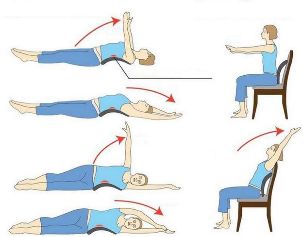
When performing such exercises, avoid vigorous movements, high amplitude, including twisting:
- sat on the floor, leaning forward, trying to touch the opposite foot with the palm of his hand;
- sit on a chair or stool, extend your arms forward and slowly turn from side to side;
- while sitting on the floor, put his arms around his knees, pull as close to his chest as possible.
In the first lessons, the exercises should be repeated 5-7 times, after about a month - 15-20 times.
Physiotherapy
Magnetic therapy, laser therapy, UHF therapy, sinusoidal current, shock wave therapy, applications with paraffin and ozokerite are used in the treatment of osteonecrosis of the chest. During an exacerbation, electrophoresis, ultrasound with glucocorticosteroids, anesthetics, B vitamins, chondroprotectors is performed.
Massage
Massage performed by specialists helps to eliminate soreness between the shoulder blades, relax spasm skeletal muscles.
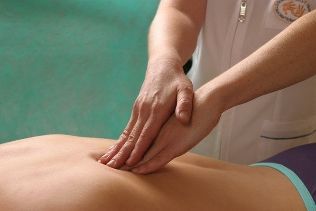
In the case of osteonecrosis, all types of massage have a therapeutic effect - classical, vacuum aspiration, acupuncture, connective tissue. At home, you can conveniently massage yourself with a wooden or electric massage machine with a long handle.
Acupuncture
Acupuncture is a medical treatment by inserting needles into the acupuncture points with biological activity on the human body. They are thin, short, so when they penetrate the skin there is only occasional feeling of discomfort. But even this effect is sufficient for the production of substances in the body that have analgesic and anti-inflammatory effects.
Nutrition
Nutritionists advise patients with necrosis of the chest to give up fatty meats, rich soups, smoked meats, homemade and factory sauces. It is important to limit the amount of salt in the diet that can cause edema. Every day you need to drink about 2. 5 liters of fluids - water, vegetable juice, drinks from berry, fruit juice.
Folk remedies
Medicines and infusions of medicinal plants, ointments, alcohols and ointments, are approved by a neurologist for use after the main therapy. Folk remedies are used to get rid of mild pain between the shoulder blades, sometimes arising after exertion.
Celery root
Peel the large celery, chop it, and squeeze the juice. Add 100 g of chopped fresh celery. Drink 3 tablespoons up to 4 times a day with meals to clean the vertebral structures of harmful salts.
Sunflower root
Pour 1 teaspoon of crushed dried sunflower root with a cup of hot water. Bring to a boil, let low heat for 20 minutes, cover and let cool, drain. Drink 3-4 times a day.
Home ointment
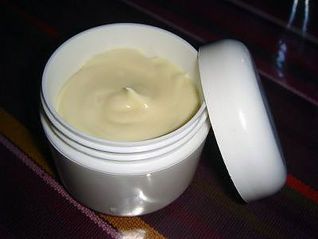
In the jar, grind a spoonful of gum resin and thick honey, add 2 drops of juniper, rosemary, and eucalyptus essential oils each. Inject in small portions of 100 g of medical mineral oil. Stir, transfer to jars, store in refrigerator, rub on back pain.
During pregnancy
Many systemic pain relievers are contraindicated during pregnancy, so neurologists favor topical drugs - ointments, gels, patches. If you cannot do it without taking the medicine, then their dosage is greatly reduced. During the childbirth period, the main methods of treatment for fibroids are massage and exercise.
Possible consequences
In the absence of medical intervention, thoracic necrosis can cause atherosclerosis, arrhythmia, vascular dystonia, impaired gastrointestinal tract, impaired reproductive and sexual function. sex in women and men.
Prevention and Prognosis
Favorable prognosis when timely detecting disease, comprehensive and competent treatment. If complications of thoracic necrosis have developed, then simply adhering to all medical recommendations will allow for steady remission.
As a preventive to pathology, neuroscientists recommend to exclude factors that provoke it from your normal lifestyle. This is overweight, poor physical activity, vitamin and mineral deficiencies, and excessive stress on the spine.












































